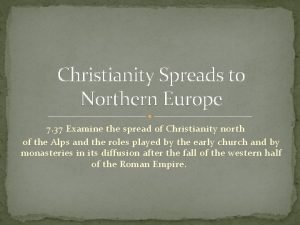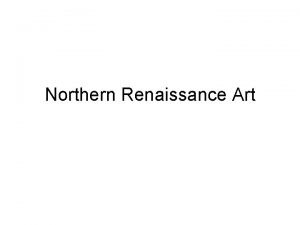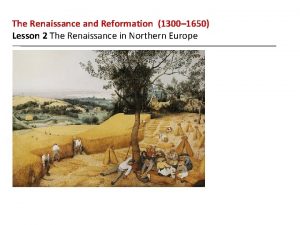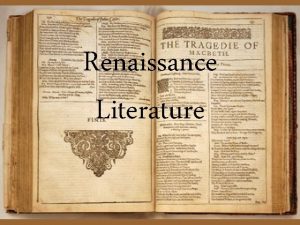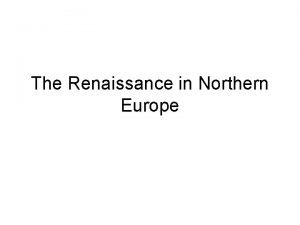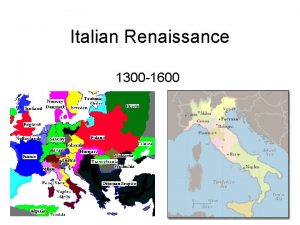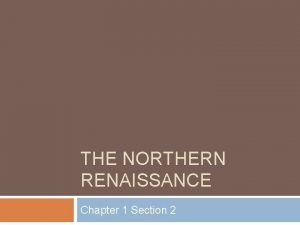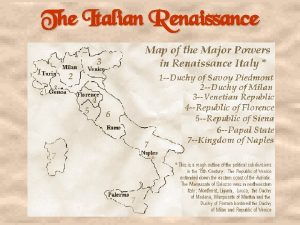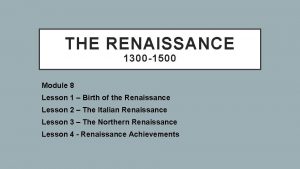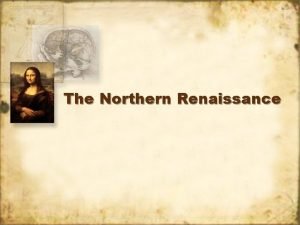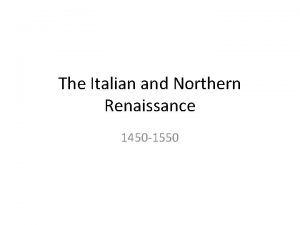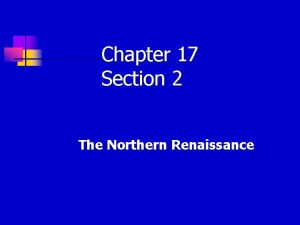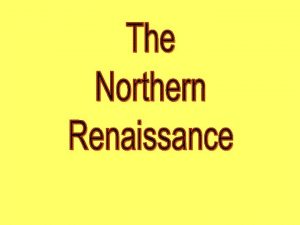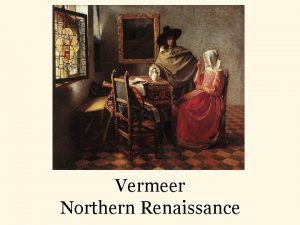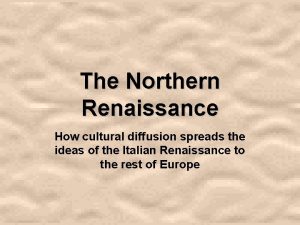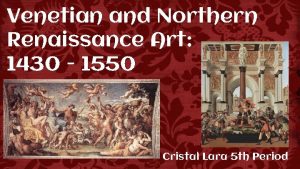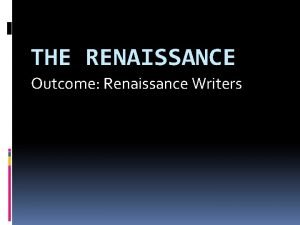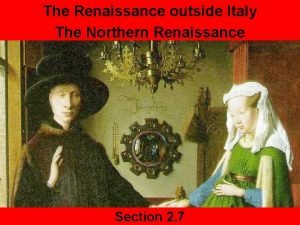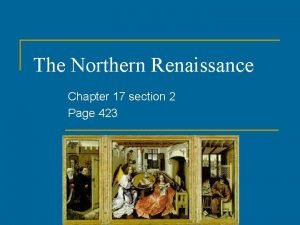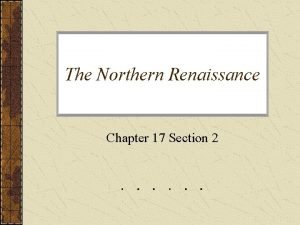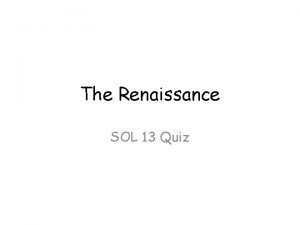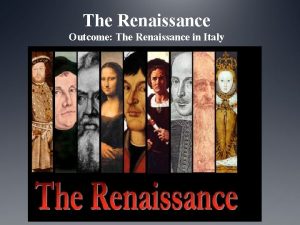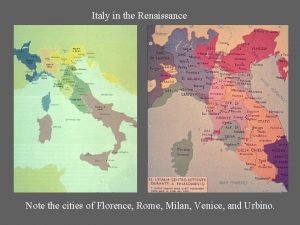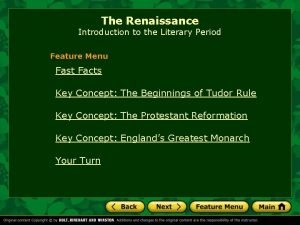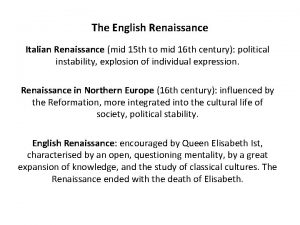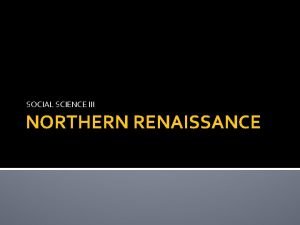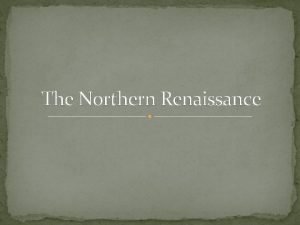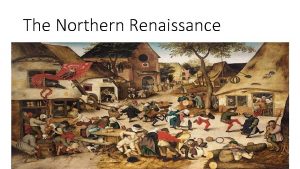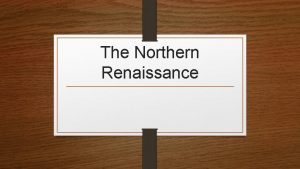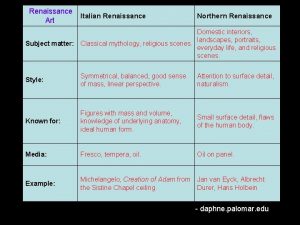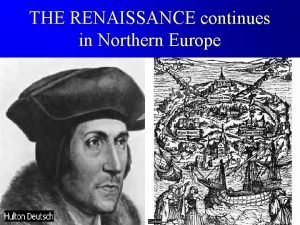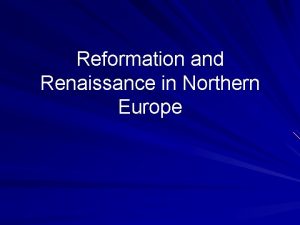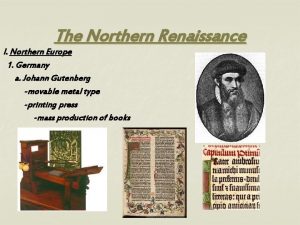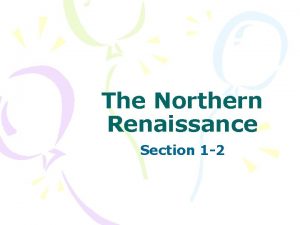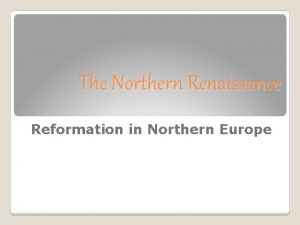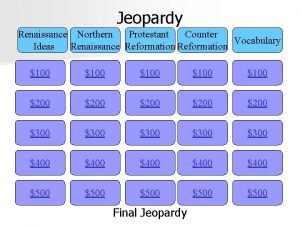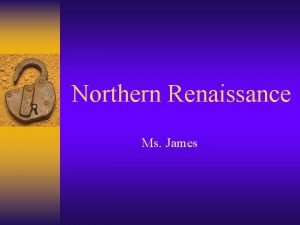THE NORTHERN RENAISSANCE Where was the Northern Renaissance












































- Slides: 44

THE NORTHERN RENAISSANCE

Where was the Northern Renaissance? England France Germany Flanders (Netherlands/Belgium)

By late 1400 s Northern Europe adapts to Renaissance 1. 2. 3. Interest in classical culture A curiosity about the world A belief in human potential

Factors leading to Renaissance in Northern Europe Population recovers from plague Hundred Years’ War ends in 1453 Patrons Cities grow rapidly England France unify under strong monarchs who are art patrons Students and visitors from Italy bring back ideas Artists and writers move to northern Europe fleeing war in Italy (1494)

Characteristics Northern Renaissance artists interested in realism Humanists interested in social reform based on Judeo-Christian values

Northern Renaissance Artists Albrecht Durer (German) Woodcuts and engravings Religious subjects Realistic landscapes Classical myths Influenced Hans Holbein

Albrecht Durer Painting of his father Engraving

Northern Artists Jan van Eyck’s paintings are realistic Flemish used oil based and layers of paint

Jan van Eyck The Arnolfini Portrait Oranges-symbols of fertility Dog represents fidelity Mirror stands for purity Single burning candle symbolizes the all seeing Christ People reflected in the mirror in the back Shoes off-holy ground Above the mirror— writing “Johannes de Eyck fuit hic 1434”

Fresco painting Fresco---Painting on wet plaster Fresco used by Michelangelo in the Sistine Chapel However, oil painting used by Jan Van Eyck

Northern Artists Pieter Bruegel the Elder Flemish Peasant life Realistic details and individuals Scenes from everyday life

Bruegel

Bruegel

Bruegel � Peasant Wedding � The bride sits under the paper crown � Notice the furnishings � Groom may be the one sitting across from the bride � Relaxed, humorous, and focused on ordinary people

What can be learned about people’s daily lives from examining the painting Peasant Wedding? Where ordinary people lived, what they ate, how they dressed, how they celebrated

Hans Holbein the Younger German painter who moved to London and painted for Henry VIII

Hans Holbein the Younger Portrait of Anne of Cleves Henry VIII criticized the portrait as having been too flattering

What factors might have influenced the trend toward a more realistic style of art? Artists could travel and thereby learn better techniques; oil paints made more realistic, subtle paintings possible

Northern Writers Criticize the Catholic Church, start Christian humanism Want to reform society and promote education, particularly for women

Northern Writers Desiderius Erasmus (picture by Holbein) From Holland wrote in Latin Christian humanist Wrote The Praise of Folly which poked fun at flaws in real people Said people should read the Bible Wanted Church reform but not separate church

Northern Writers Thomas More English and wrote in Latin Concerned with society’s flaws Utopia-tried to show ideal model of society (no war, corruption, greed, little use of money) Utopia means “no place” in Greek Beheaded because would not accept Henry VIII as head of the Church of England

Utopia Who ruled in Plato’s ideal society? The philosopher king The goal of More’s Utopia was social and political equality for all.

What similarities were there in the works of Erasmus and Thomas More? Both wanted to improve society; both believed that greed caused problems

Women’s Reforms Christine de Pizan, one of the first women writers She promotes education, equal treatment for boys and girls

Christine De Pizan “ I am amazed by the opinion of some men who claim that they do not want their daughters, wives, or kinswomen to be educated because their mores (morals) would be ruined as a result…Here you can clearly see that not all opinions of men are based on reason and that these men are wrong. ”

Northern Writers � William Shakespeare �English; born in Stratford -upon-Avon in 1564 �Plays examine human flaws �Drew on Greek and Roman classics �Tragedies: Macbeth, Hamlet, Orthello, King Lear �Comedies: A Midsummer Night’s Dream �The Taming of the Shrew

Phrases from Shakespeare’s plays Today, almost 400 years after his death, the language of Shakespeare is all around us. “at one fell swoop” “foul play” “good riddance” “high time” “lie low” “Mum’s the word” “vanish into thin air” “neither here nor there” “the game is up”

Elizabethan Age 1558 -1603 Queen Elizabeth Ipatron of the arts

Elizabeth I How did Elizabeth I contribute to the Renaissance? She was well educated and supported writers and artists. She spoke and could read six languages: English, French, Italian, Spanish, Greek, and Latin.

Printing Spreads Renaissance Ideas Chinese Invention Around 1045 Bi Sheng of China invents movable type

Gutenberg Improves the Printing Press Around 1440 Johann Gutenberg of Germany develops printing press Printing press allows for quick cheap book production First book printed with movable type, Gutenberg Bible (1455)

Gutenberg He printed 200 copies of the Bible. Invented oil-based ink. Soon after he printed his Bible, his creditors took over the press because he failed to repay his debts.

Book Production It took 5 months to copy a single book by hand One man and a printing press could produce 500 books in the same amount of time.

The History of Book Making 2700 BC Egyptians write books on papyrus scrolls 1000 BC Chinese make books by writing on strips of bamboo 300 AD Romans write on sheets of parchment (treated animal skin) 800 AD Irish monks hand-write and hand-illustrate The Book of Kells 1455 Gutenberg prints the first complete book on a printing press

Printing Press � � � How did the invention of the printing press help spread learning and Renaissance ideas? Book were cheaper (more could buy them) News quicker Rise of literacy Published accounts of maps and charts lead to more discoveries Political structures and religious practices are questioned

Printing Press

Consensus Circle: Innovations in Communication In partners, create a consensus circle to illustrate and explain “What are the most signifcant developments in the history of news/ information/idea/communication dissemination? ” List and illustrate 5 most significant developments in the history of information dissemination. Most significant in the center circle to least significant in the outer circles. Include 2 -5 explanations on why are the most significant and predict where you see each item developing in the next 5 -10 years. Answer these two questions on the paper as well in relevance to the video on News in the Digital age video. Describe what is happening to newspapers in the U. S. that is driving their transformation to more digital technology. Compare newspaper redesigns in print and newspaper distribution electronically. Is the quality of the news affected? Why or why not?

The Legacy of the Renaissance � Art influenced by classical Greece and Rome � Realistic portrayals of individuals and nature � Art is both secular and religious � Writers use vernacular � Art praises individual achievements

Globe Theater Performances were often wild affairs. If the audiences did not like the play, they booed loudly, pelted the stage with garbage (oranges, nuts, apples, and gingerbread) and sometimes attacked the actors. A full house was about 3, 000 paying customers.

City Life in the Renaissance In the 1500 s, 75% of Europeans lived in rural areas. However, many cities experienced much growth. London-200, 000 people in 1600

Cost of Living If a pound was worth $400 in today’s currency, then a shilling was worth $20 and a penny was worth about $1. 66. This means that a skilled worker earned $5, 200 per year. A merchant would earn about $40, 000. The cost of a theater performance was 1 shilling ($20) for the lords’ room, 6 pence ($10) for the gentlemen’s rooms, 2 pence ($3. 30) for the galleries, and 1 penny ($1. 66) for the pit. One in every 10 people in London went to theater at least once a week.

Food � � A typical meal for wealthy Londoners › Fish, several kinds of meat, bread, and a variety of vegetables, served on silver or pewter tableware. The diet of the poor was simpler. › Rarely ate fish, meat, or cheese. Usually their meals consisted of a pottage-a kind of soupof vegetables. They ate their meals from a hollowed out slab of bread or wood.

Renaissance Stations IN PARTNERS: Each partner groups will turn in ONE copy as PARTNERS for each station. You will be in larger groups but MUST have a partner to work with in THAT group. Station one: On a group sheet of paper, interpret the piece of art on pg. 470 (ANSWER all questions. Station two: WRITE 1015 Shakespearean insults to an antagonist in one of his plays. Station three: Using your Shakespearean words sheet interpret and WRITE one of the pieces of Shakespeare from the packet of plays.

� � � How did the northern Renaissance differ from the Italian Renaissance? Stronger interest in realistic art; more of an emphasis on changing society In what ways did Renaissance art connect to the past? Copied Greek and Roman styles, created religious works In what ways did it break with the past? Increase in secular art, more realistic style, use of vernacular, emphasis on the individual
 Italian renaissance vs northern renaissance venn diagram
Italian renaissance vs northern renaissance venn diagram Hunters in the snow artist
Hunters in the snow artist Lesson 2 the renaissance in northern europe
Lesson 2 the renaissance in northern europe Northern renaissance writers
Northern renaissance writers The renaissance in northern europe
The renaissance in northern europe Northern renaissance portraits
Northern renaissance portraits The northern renaissance chapter 1 section 2
The northern renaissance chapter 1 section 2 Northern renaissance characteristics
Northern renaissance characteristics Italian renaissance location
Italian renaissance location Lesson 1 the renaissance 1485
Lesson 1 the renaissance 1485 Renaissance art and literature
Renaissance art and literature Italian and northern renaissance similarities
Italian and northern renaissance similarities Italian and northern renaissance
Italian and northern renaissance The northern renaissance begins
The northern renaissance begins Northern renaissance art characteristics
Northern renaissance art characteristics Vermeer renaissance
Vermeer renaissance Characteristics of the northern renaissance
Characteristics of the northern renaissance What does humanism mean in the renaissance
What does humanism mean in the renaissance Venetian and northern renaissance (1430–1550)
Venetian and northern renaissance (1430–1550) Writers from the renaissance
Writers from the renaissance Renaissance outside of italy
Renaissance outside of italy Chapter 17 section 2 the northern renaissance
Chapter 17 section 2 the northern renaissance Chapter 17 section 2 the northern renaissance
Chapter 17 section 2 the northern renaissance What movement had the greatest influence on the renaissance
What movement had the greatest influence on the renaissance The renaissance outcome the renaissance in italy
The renaissance outcome the renaissance in italy Last supper labeled
Last supper labeled The renaissance introduction to the renaissance answer key
The renaissance introduction to the renaissance answer key The renaissance outcome the renaissance in italy
The renaissance outcome the renaissance in italy Italian renaissance vs english renaissance
Italian renaissance vs english renaissance The renaissance outcome renaissance painters/sculptors
The renaissance outcome renaissance painters/sculptors Cái miệng bé xinh thế chỉ nói điều hay thôi
Cái miệng bé xinh thế chỉ nói điều hay thôi Các châu lục và đại dương trên thế giới
Các châu lục và đại dương trên thế giới Từ ngữ thể hiện lòng nhân hậu
Từ ngữ thể hiện lòng nhân hậu Bổ thể
Bổ thể Tư thế ngồi viết
Tư thế ngồi viết V cc cc
V cc cc Phép trừ bù
Phép trừ bù Thể thơ truyền thống
Thể thơ truyền thống Chúa sống lại
Chúa sống lại Hổ sinh sản vào mùa nào
Hổ sinh sản vào mùa nào đại từ thay thế
đại từ thay thế Diễn thế sinh thái là
Diễn thế sinh thái là Vẽ hình chiếu vuông góc của vật thể sau
Vẽ hình chiếu vuông góc của vật thể sau Công thức tiính động năng
Công thức tiính động năng Thế nào là mạng điện lắp đặt kiểu nổi
Thế nào là mạng điện lắp đặt kiểu nổi
